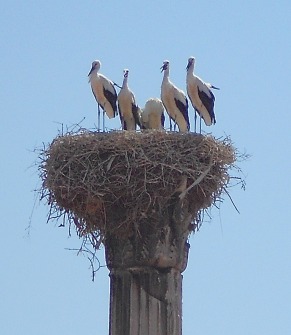The ancient Mylasa Population: 71,000
Market day: Tuesday
Old name: Mylasa
Milas, in southwest Turkey just inland form Bodrum, is a fascinating little town. Unfortunately, like Bergama, it is not well served by modern development that has dumped a long canyon of modern high-rises all the way down from the main road to the town centre. Most visitors would take one look and quickly conclude that there was nothing to see here which is a great shame because those who persevere eventually stumble upon a thoroughly delightful old core full of ancient ruins and lovely old houses and mosques.
Tour groups from Bodrum are brought to Milas to visit the Tuesday market.
Backstory
Milas has a long and venerable history, first as Mylasa, the original capital of the Carian kings before they relocated to Halikarnas (Bodrum), then as a Roman settlement, then later as an important city of the Menteşe Beylik which bestowed several fine mosques on the town before the Ottomans took over.
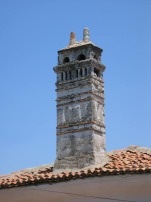 Typical Milas chimneyAround town
Typical Milas chimneyAround town
Milas’ most famous monument is a late 2nd-century Roman tomb called the Gümüşkesen, a particularly unlikely name which means “silver-cutting” (or “silver purse” in some translations). A marble tomb with elaborate columns and a pyramidal roof, it was probably modelled on the much more famous Mausoleum of Halicarnassus in nearby Bodrum.
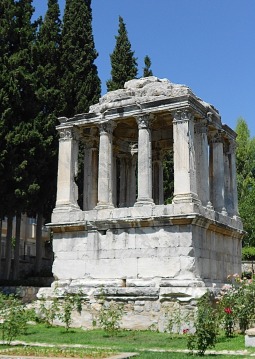 Mausolus, who gave his name to that particular ex-Wonder of the World, came from a family that originally hailed from Milas. It’s easy, therefore, to imagine a local noble wanting to commemorate the town’s most famous son by making a mini version of the tomb for the ancestral bolthole. Given that the original Mausoleum has virtually vanished, the Gümüşkesen does a great job of hinting at its lost splendour.
Mausolus, who gave his name to that particular ex-Wonder of the World, came from a family that originally hailed from Milas. It’s easy, therefore, to imagine a local noble wanting to commemorate the town’s most famous son by making a mini version of the tomb for the ancestral bolthole. Given that the original Mausoleum has virtually vanished, the Gümüşkesen does a great job of hinting at its lost splendour.
Whoever was buried inside it, their remains have long since vanished. Until recently the monument sat in a pretty small park where old men passed the day beneath an arbour. Then someone decided to build a museum beside it. The work was brought to a halt but not before the concrete shell had been erected, wrecking the beauty of the site.
The Gümüşkesen is not particularly easy to find – if you stand in the market place you can just about see it, then try to make a beeline through the narrow streets towards it. Just up the road from it a sign points to the old Jewish Cemetery where many gravestones still survive intact.
Until recently the most important other monument to see in Milas was the site of a Temple of Zeus believed to date back to the 1st century BC. Rather like the Temple of Artemis in Selçuk, this temple has managed to hang on to only one of its original columns, on top of which can be seen an unruly stork’s nest, reused year after year. But extensive excavations around and beneath the temple in 2010 revealed first the marble-flagstoned agora and then the incredible frescoed mausoleum of Hecatomnus, the father of King Mausolus. It dates back to the 4th century BC and contains a sarcophagus covered with bas reliefs. The mausoleum is open to the public except on Mondays and is already listed on UNESCO’s list of potential world heritage sites.
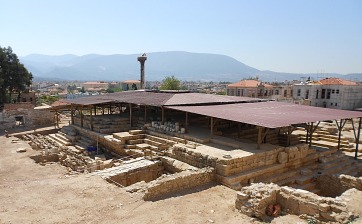 A short walk away from the remains of the temple stands a more conspicuous reminder of Mylasa: the Baltalı Kapı (Axe Gate) which straddles a modern road. The gate took its name from an axe carved over the keystone and visible even today. As late as the 18th century it would still have been part of the city walls but nowadays it stands alone, opening on to a street of battered old houses. Further remains, fenced off and unlabelled, can be seen in a field beside the minibus terminal.
A short walk away from the remains of the temple stands a more conspicuous reminder of Mylasa: the Baltalı Kapı (Axe Gate) which straddles a modern road. The gate took its name from an axe carved over the keystone and visible even today. As late as the 18th century it would still have been part of the city walls but nowadays it stands alone, opening on to a street of battered old houses. Further remains, fenced off and unlabelled, can be seen in a field beside the minibus terminal.
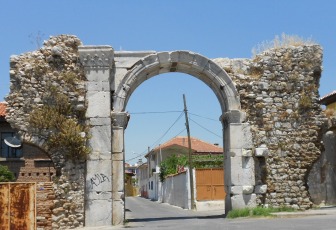 For reasons now lost in the mists of time, Milas seems to have gone into a decline at the end of the Roman period; there are hardly any traces of the Byzantines here.
For reasons now lost in the mists of time, Milas seems to have gone into a decline at the end of the Roman period; there are hardly any traces of the Byzantines here.
But then in the 14th century things perked up again when the Menteşe emirate (the local successor state to the Selçuk Sultanate) set up its capital at nearby Becin. As a result Milas boasts several fine mosques and other buildings dating from that period. The finest is the Fıruz Bey (Kurşunlu) Cami (1394), a spectacular mosque with fantastic carving around its door, windows and portico that comes paired with a long medrese that was restored in 2007. Internally it is reminiscent of the early Ottoman mosques in Bursa with steps up to the praying area and two side chambers.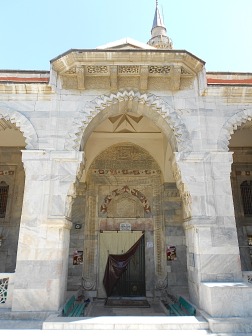
In contrast the Ulu Cami is a solid brick shed of a building dating back to 1378; instead of a minaret it has a tiny turret accessed via steps running up the side of the building, a unique feature to the best of my knowledge. It is also held in place with two huge buttresses that loom over an alleyway popular with men on motorcycles. Inside the mosque stand a row of columns clearly filched from the ruins of Mylasa.
Nor does it take much looking at the outside walls to realise where the building materials must have come from – the Menteşes are revealed as early advocates of recycling who made excellent use of the remains of Mylasa to decorate their own buildings. You’ll find the same thing at the Belen (1750), Abdülaziz Ağa (1737) and Salaheddin Camis (1330) – old pieces of marble column and presumably meaningless old Greek inscriptions put to new and decorative use in the walls of Menteşe mosques.
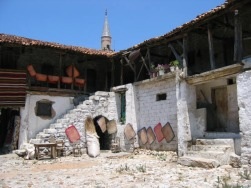 The Cöllühanı before restorationOnce the Ottomans took over Milas appears to have moved up in the world quite literally, because many of the lovely old houses with their decorative chimneystacks that still survive are on the hillside. Here, too, stands the elegant 18th-century inn, the Çöllühanı, built of wood and stone. Until recently you could still meet one of the town’s last saddle-makers as well as a man who sells lovely small rugs made out of felt here but the mania for renovation has finally caught up with the han which is now altogether smarter although still very lovely. It’s right beside the Belen Cami.
The Cöllühanı before restorationOnce the Ottomans took over Milas appears to have moved up in the world quite literally, because many of the lovely old houses with their decorative chimneystacks that still survive are on the hillside. Here, too, stands the elegant 18th-century inn, the Çöllühanı, built of wood and stone. Until recently you could still meet one of the town’s last saddle-makers as well as a man who sells lovely small rugs made out of felt here but the mania for renovation has finally caught up with the han which is now altogether smarter although still very lovely. It’s right beside the Belen Cami.
The Ottoman Milasians grew rich on the proceeds of trading tobacco and cotton, a trade that was largely controlled by the Greeks, Armenians and Jews whose magnificent houses stand in varying states of repair around the han. Many are pastel-coloured with red-tiled roofs and Greek-style motifs adorning them. Remains of the synagogue stand behind a locked metal gate although a Hebrew inscription above it gives the game away.
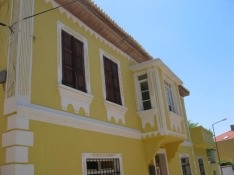
Perhaps the most striking feature of the houses is their soaring brick chimneys with jaunty brick-patterned caps, a feature they share with nearby Muğla and the village of Çomakdağ. At one time some of the houses stood on the banks of a river which was crossed by a fine triple-arched Ottoman bridge. This still survives today although the river has dried up.
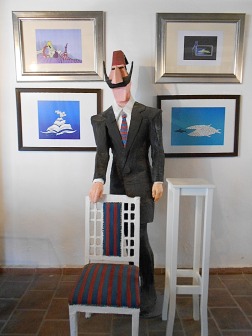 Uphill from the Ulu Cami the Hacı Ali Ağa Konağı has been restored to house a small museum dedicated to the Milas-born cartoonist Turhan Selçuk (1922-2010). Some of his drawings are reproduced on the walls of a small park in his name near the Baltacı Kapı.
Uphill from the Ulu Cami the Hacı Ali Ağa Konağı has been restored to house a small museum dedicated to the Milas-born cartoonist Turhan Selçuk (1922-2010). Some of his drawings are reproduced on the walls of a small park in his name near the Baltacı Kapı.
Across the road from the Ulu Cami is the Milas Museum, a fairly indifferent offering containing some finds from Herakleia ad Latmos, Iasos and Stratonikeia, as well as a few fine figurines dug up when a new school was being built near the Gümüşkesen. One of the most striking exhibits is the reconstruction of the interior of a tomb found at Çakıralan on the way to Ören during coal mining; it comes complete with a table and a pair of stone couches for visitors to dine there in memory of the dead whose ashes lay in caskets beneath them. Look out also for some Jewish gravestones in the grounds (the Jews left in the 1950s; the Greeks had already left in the 1920s).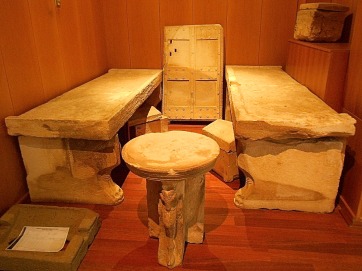
Milas’ bazaar is not as atmospheric as Muğla’s but if you poke about in the back streets you may come across another old han which at one time served as the Otel Sefa.
Milas offers many small pleasures, not least the fascination of finding bits of old Mylasa cropping up in virtually every old building. If you’re staying at the Sürücü or visiting the Tansaş supermarket you might also like to inspect a string of very European-looking houses that turn out to have been designed by a Hungarian architect in the 1920s. Nearby is the “House of Madame Murad”, romantically built in 1927 by a local notable, Murad Salih Menteşe, for his French wife, Marie Suzanne Dugenie; note their initials M and S in the ironwork of the gate.
At one time Milas boasted a flourishing olive-oil industry and as you walk west along İnönü Caddesi you will still see the old brick towers as in Ayvalık on the Northern Aegean coast.
Sleeping
Few tourists choose to stay in Milas since Bodrum is so near, so most Milas hotels cater for a business clientele. However, Milas actually makes a better base than Bodrum if you want to explore the rich archaeological heritage of this corner of Turkey. Expect a boutique hotel to open in one of the old Greek houses when the excavations around the Temple of Zeus are completed.
Eldehan Otel. Tel: 0252-5
Milashan Otel. Tel: 0252-513 7901
Transport info
Most bus services to Bodrum from northern Turkey transit the Milas otogar; regular dolmuşes, marked Şehir İçi carry passengers into the town centre.
There are also local dolmuş services to Milas from Bodrum, Yatağan and Muğla.
The otogar is in a horrible location on the main road well away from the actual town. A new minibus terminal (köy garaj) for services to Ören, Güllük, Selimiye (for Euromos) and Kıyıkıslacık (for Iasos) is at the end of the street running diagonally behind the museum. Most of these services also pass a more central bus stop on the main road behind the Belediye Parkı if you don’t mind the risk that they will arrive full. The Yatağan and Muğla minibuses leave from just outside the minibus terminal.
Day trip destinations
